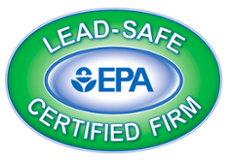The final step is now here. RRP is on its way to include public and commercial buildings. With Congress just avoiding the Financial Cliff last night, EPA released their announcement yesterday. To many of you in commercial work, you might have chosen the other Financial Cliff to this one — yet to the residential contractor who has been forced to learn how to deal with this regulation, we say its about time.
 “EPA is currently in the process of determining whether renovation, repair, and painting activities on public and commercial buildings might also create lead-based paint hazards. For those activities that do create lead-based paint hazards, EPA intends to develop certification, training, and work practice requirements as directed by the Toxic Substances Control Act (TSCA).
“EPA is currently in the process of determining whether renovation, repair, and painting activities on public and commercial buildings might also create lead-based paint hazards. For those activities that do create lead-based paint hazards, EPA intends to develop certification, training, and work practice requirements as directed by the Toxic Substances Control Act (TSCA).
EPA has opened a comment period to allow for additional data and other information to be submitted by the public and interested stakeholders. This comment period runs through April 1, 2013. More information on this request for public comment, including instructions for providing your comments, can be found in the Federal Register notice at https://www.federalregister.gov/articles/2012/12/31/2012-31532/lead-renovation-repair-and-painting-program-for-public-and-commercial-buildings-request-for.
In addition, EPA plans to hold a public meeting on renovations in and on public and commercial buildings on June 26, 2013. EPA will publish more details on this public meeting in the Federal Register in the spring of 2013.”
If you have found yourself in the past complaining of the RRP regulation, its time for you to act before this expands into all commercial and public buildings. Follow the above link for instructions on how to submit your comments. However, I will advise you to do your homework. If your intention is to simply vent frustrations without solid data to back up your position, you are wasting your time. Angry with the added costs you feel RRP or other safety standards add to your project? Better use a different approach – OSHA and EPA feel a workers’ life is priceless.
Commercial contractors are accustomed to complying with safety standards much before RRP ever hit the town. OSHA has many regulations dealing with hazardous materials such as lead in construction (1926.62) as well as asbestos (1926.1101), cadmium (1926.1127) and other carcinogen (1910.1003) issues that are known to cause death or serious health issues.
By the Way, so are you obligated, the residential employer, when it comes to dealing with protecting your employees health and safety — even if there is no current RRP application to your project. The world of OSHA compliance can seem overwhelming to the typical small contractor. We take our clients through the maze a step at a time. Working Safely is a cultural journey not a sprint. Consider downloading OSHA’s S&H Checklist and start the year off on the right foot.
IF you do take the time to submit your comment, perhaps think of it in this way — You have an employee whom you have placed in charge of a kitchen renovation. The project is moving along riddled with poor decisions, the punch list is growing, behind schedule, your crew demoralized and the budget for the project is depleted. Your employee comes to you asking to be placed in charge of a new project to construct a 7,000 sq. ft. home your firm is about to start claiming he/she is much better at a new home than a remodeled kitchen.
What reasons would you base your decision on? Promises or past performance? Should you give him/her a chance at something larger when they haven’t impressed you with their performance to date? Now pick up pen and write – or forever hold your comments to yourself.
Peter
